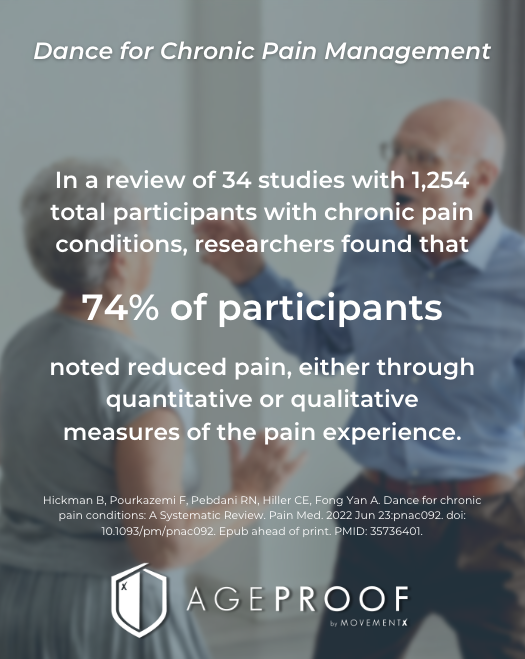Pain
In this article, we will review a topic that is relevant for all individuals and the larger healthcare system at large – Pain.
Pain is a complex and widely misunderstood topic. Below, we share several articles and a video resource that can help you navigate your own pain experience, and help support and understand others experiencing pain.
1. Understanding Pain Reduces Pain
Uncertainty about pain – where it comes from or what's causing it – can lead to increased fear of pain or fear of movement. Less movement can increase pain further and create a negative feedback loop.
However, education is a great place to start! Specifically, Pain Neuroscience Education (PNE) teaches individuals about pain and the nervous system's role in pain.
This systematic review compiled results from 13 different studies examining the effects of PNE. They determined that PNE is indeed useful in chronic musculoskeletal pain conditions…
📉 To reduce pain & disability
🧠 To improve function and patient knowledge of pain
👥 To reduce psychosocial factors
🏥 To reduce healthcare utilization
Pain neuroscience education can be useful in reducing pain and improving one's function and self-efficacy. This special knowledge hopefully inspires a process of active learning and problem-solving in the individual toward their specific goals.
Check out the video below, which overviews the origins of our understanding of pain and shares a common analogy that is helpful in explaining pain.
2. Dance for Chronic Pain Management
20-25% of people globally will experience chronic pain (pain lasting >3 months) in their lifetime.
Dance has been researched as a treatment for pain, given its potential physical and psychosocial benefits.
• 👣 Physical = relating to the body & physical function
• 🧠 Psycho- = relating to the mind or spirit
• 👭 -Social = relating to others or a community
Physical benefits can include improved agility, coordination, and speed, while psychosocial benefits can include coping with pain, acceptance, and finding support in community with others.
This systematic review compiled results from 34 studies, which examined 1,254 total participants with fibromyalgia (26%) and generalized chronic pain (14%), and their response to a variety of dance-based interventions.
Overall, they found that 74% of participants noted reduced pain, either through quantitative measures or qualitative themes relating to the pain experience.
Dance can be a useful adjunct treatment in the management of chronic pain, by getting our blood flowing, our limbs moving, our brains firing, as well as by by strengthening our relationships with others.
3. Weightlifting to Improve Low Back Pain
Standard treatment for individuals with chronic low back pain usually includes some combination of pain education and exercise. But which type of resistance-based exercise pairs best with education for pain relief?
In this study, two groups (bodyweight exercise & powerlifting) performed 1-on-1, 60 minute sessions with the last 5–15 mins focusing on pain education.
They found that there were no significant differences observed for pain or disability at any time during the study. Both forms of resistance training were safe and beneficial, with reductions in pain, disability, and fear, as well as improved self-efficacy.
Many forms of movement can be helpful to manage in low back pain. We recommend to link up with a physical therapist or exercise community that can help you find and maintain a consistent exercise regimen to stay active and build an arsenal of movement options across the lifespan.
4. Sleep & Pain – A Bidirectional Relationship
Sleep is a fundamental element to overall health. In addition to improving cognitive performance and emotional regulation, recent research has also pointed to its specific role in pain management and processing.
In this study from 2014, researchers monitored participants' low back pain and sleep using wearable technology and a diary.
Their results showed a bidirectional relationship between sleep and pain. In other words, a night of poor sleep quality was followed by a day with higher pain intensity. Moreover, a day with higher pain intensity was followed by a night of poor sleep quality.
In other words, sleep disturbances and pain intensity both seem to increase the other. This can create a negative feedback loop of more pain and less sleep.
Fortunately, this also means that by improving one, you'll usually improve the other. This creates a positive feedback loop between better sleep quality and reduced pain.
Works Cited
Louw A, Zimney K, Puentedura EJ, Diener I. The efficacy of pain neuroscience education on musculoskeletal pain: A systematic review of the literature. Physiother Theory Pract. 2016 Jul;32(5):332-55. doi: 10.1080/09593985.2016.1194646. Epub 2016 Jun 28. PMID: 27351541.
Hickman B, Pourkazemi F, Pebdani RN, Hiller CE, Fong Yan A. Dance for chronic pain conditions: A Systematic Review. Pain Med. 2022 Jun 23:pnac092. doi: 10.1093/pm/pnac092. Epub ahead of print. PMID: 35736401.
Gibbs MT, Morrison NM, Raftry S, Jones MD, Marshall PW. Does a powerlifting inspired exercise programme better compliment pain education compared to bodyweight exercise for people with chronic low back pain? A multicentre, single-blind, randomised controlled trial. Clinical Rehabilitation. 2022;36(9):1199-1213. doi:10.1177/02692155221095484
Alsaadi SM, McAuley JH, Hush JM, Lo S, Bartlett DJ, Grunstein RR, Maher CG. The bidirectional relationship between pain intensity and sleep disturbance/quality in patients with low back pain. Clin J Pain. 2014 Sep;30(9):755-65. doi: 10.1097/AJP.0000000000000055. PMID: 24451630.





